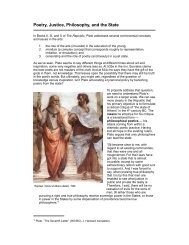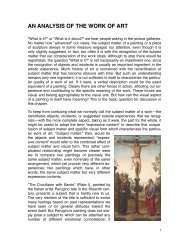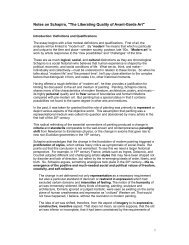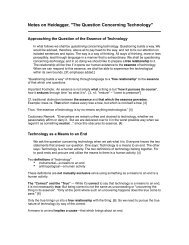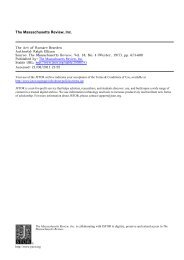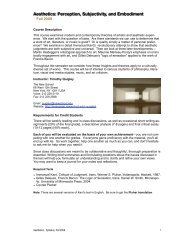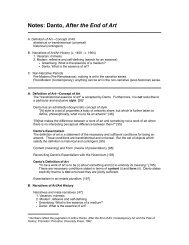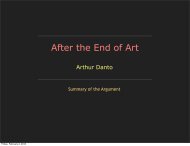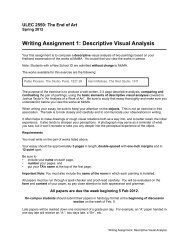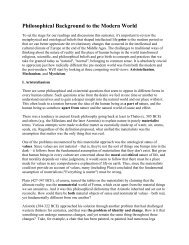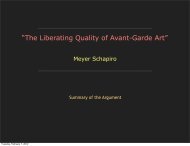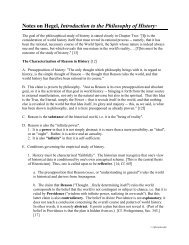You also want an ePaper? Increase the reach of your titles
YUMPU automatically turns print PDFs into web optimized ePapers that Google loves.
ubiquity of the body which brings it about that the person bestrides space. The picturemakes movement visible by its internal discordance. Each member's position, preciselyby virtue of its incompatibility with that of the others (according to the body's logic), isdated differently or is not "in time" with the others; <strong>and</strong> since all of them remain visiblywithin the unity of one body, it is the body which comes to bestride duration. Itsmovement is something conspired between legs, trunk, arms, <strong>and</strong> head in some locus ofvirtuality, <strong>and</strong> it breaks forth only subsequently by actual change of place. When a horseis photographed at that instant when he is completely off the ground, with his legs almostfolded under him—an instant, therefore, when he must be moving—why does he look asif he were leaping in place? And why, by contrast, do Gericault's horses really run oncanvas, in a posture impossible for a real horse at a gallop? It is because the horses inEpsom Derby bring me to see the body's grip upon the ground <strong>and</strong> that, according to alogic of body <strong>and</strong> world I know well, these "grips" upon space are also ways of takinghold of duration. Rodin said profoundly, "It is the artist who is truthful, while thephotograph lies; for, in reality, time never stops."[52] The photograph keeps open theinstants which the onrush of time closes up forthwith; it destroys the overtaking, theoverlapping, the "metamorphosis" [Rodin] of time. This is what painting, in contrast,makes visible, because the horses have in them that "leaving here, going there,"[53]because they have a foot in each instant. Painting searches not for the outside ofmovement but for its secret ciphers, of which there are some still more subtle than thoseof which Rodin spoke. All flesh, <strong>and</strong> even that of the world, radiates beyond itself. Butwhether or not one is, depending on the era <strong>and</strong> the "school," attached more to manifestmovement or the monumental, the art of painting is never altogether outside time,because it is always within the carnal.Now perhaps we have a better sense of how much is contained in that little word "see."Seeing is not a certain mode of thought or presence to self; it is the means given me forbeing absent from myself, for being present from within at the fission of Being only at theend of which do I close up into myself.Painters have always known this. Da Vinci invoked a "pictorial science" which does notspeak in words (<strong>and</strong> still less in numbers) but in works that exist in the visible just asnatural things do—yet pass on that science "to all the generations of the universe."[54] Asilent science, says Rilke (apropos of Rodin), that brings into the work the forms of things"whose seal has not been broken"; it comes from the eye <strong>and</strong> addresses itself to the eye.[55] We must underst<strong>and</strong> the eye as the "window of the soul." "The eye. . . through whichthe beauty of the universe is revealed to our contemplation is of such excellence thatwhoever should resign himself to losing it would deprive himself of the knowledge of allthe works of nature, the sight of which makes the soul live happily in its body's prison,thanks to the eyes which show him the infinite variety of creation: whoever loses themab<strong>and</strong>ons his soul in a dark prison where all hope of once more seeing the sun, the lightof the universe, must vanish." The eye accomplishes the prodigious work of opening thesoul to what is not soul—the joyous realm of things <strong>and</strong> their god, the sun.A Cartesian can believe that the existing world is not visible, that the only light is of themind, <strong>and</strong> that all vision takes place in God. A painter cannot agree that our openness tothe world is illusory or indirect, that what we see is not the world itself, or that the mindhas to do only with its thoughts or another mind. He accepts, with all its difficulties, themyth of the windows of the soul; what is without place must be subjected to a body—or,what is even more: what is without place must be initiated by the body to all the others<strong>and</strong> to nature. We must take literally what vision teaches us: namely, that through it wetouch the sun <strong>and</strong> the stars, that we are everywhere at once, <strong>and</strong> that even our power toimagine ourselves elsewhere—"I am in Petersburg in my bed, in Paris, my eyes see thesun"[56]—or freely to envision real beings, wherever they are, borrows from vision <strong>and</strong>employs means we owe to it. Vision alone teaches us that beings that are different,"exterior," foreign to one another, are yet absolutely together, are "simultaneity"; which isa mystery psychologists h<strong>and</strong>le the way a child h<strong>and</strong>les explosives. Robert Delaunaysays succinctly, "The railroad track is the image of succession which comes closest to the16



